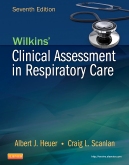
Clinical Assessment In Respiratory Care Quizlet
Nov 27, 2017 1-16 of 43 results for 'clinical assessment in respiratory care' Wilkins' Clinical Assessment in Respiratory Care Nov 27, 2017. Clinical Assessment in Respiratory Care, 6e 6th (sixth) Edition by Wilkins PhD RRT FAARC, Robert L., Dexter MD FACP FCCP, J published by Mosby (2009) 2009. By Wilkins PhD RRT FAARC. Case Study Answers for Nursing Diagnosis Handbook 11th Edition by Ackley. Physiology Essentials of Respiratory Care 6th Edition by Des Jardins. For Clinical. Learn clinical assessment in respiratory care with free interactive flashcards. Choose from 500 different sets of clinical assessment in respiratory care flashcards on Quizlet.
Clinical Assessment In Respiratory Care 6th Edition Answers Answers
Learn to assess and treat respiratory care disorders! Now in full color, Clinical Manifestations and Assessment of Respiratory Disease, 6th Edition bridges normal physiology and pathophysiology to provide a solid foundation in recognizing and assessing conditions. Authors Terry Des Jardins and George G. Burton describe how to systematically gather clinical data, formulate an assessment, make an objective evaluation, identify the desired outcome, and design a safe and effective treatment plan, while documenting each step along the way. Unique coverage of Therapist-Driven Protocols (TDPs) prepares you to implement industry-approved standards of care.
Unique! Clinical scenarios connect to specific diseases so you can better understand the disease and the treatment modalities used.Unique! A focus on assessment and Therapist-Driven Protocols (TDPs) emphasizes industry-approved standards of care, providing you with the knowledge and skills to implement these protocols into patient care. Case studies help in applying information to assessment and treatment. Overview boxes summarize the clinical manifestations caused by the pathophysiologic mechanisms of each disorder. End-of-chapter questions include multiple-choice, short answer, matching, and case studies to test knowledge and understanding, pointing out areas that might require further study. A glossary of key terms with definitions is included in the back of the book.Appendices offer easy access to information such as calculations, symbols, medications, and measurements, plus answers to selected case studies.
A unique full-color design enhances content and shows realistic examples of diseases and conditions.Student-friendly features reinforce learning with chapter outlines, objectives, and key terms.A consistent presentation of disease information shows background, treatment, and assessment for each condition so you learn the material in a clear, cohesive manner.Over 15 additional case studies with answers are added to the companion Evolve website.
Sample questions asked in the 6th edition of Clinical Manifestations & Assessment of Respiratory Disease:
List the normal lung volumes and capacities of normal recumbent subjects who are 20 to 30 years of age.
Which of the following is considered the hallmark of bronchiectasis? a. Chronic cough and large quantities of foulsmelling sputum b. Abnormal bronchogram c. Acute ventilatory failure superimposed on chronic ventilatory failure d. Presentation as both a restrictive and obstructive pulmonary disorder
Of the six types of Haemophilus influenzae, which type is most frequently pathogenic? a. Type A b. Type B c. Type C d. Type D
Unique! Clinical scenarios connect to specific diseases so you can better understand the disease and the treatment modalities used.Unique! A focus on assessment and Therapist-Driven Protocols (TDPs) emphasizes industry-approved standards of care, providing you with the knowledge and skills to implement these protocols into patient care. Case studies help in applying information to assessment and treatment. Overview boxes summarize the clinical manifestations caused by the pathophysiologic mechanisms of each disorder. End-of-chapter questions include multiple-choice, short answer, matching, and case studies to test knowledge and understanding, pointing out areas that might require further study. A glossary of key terms with definitions is included in the back of the book.Appendices offer easy access to information such as calculations, symbols, medications, and measurements, plus answers to selected case studies.
A unique full-color design enhances content and shows realistic examples of diseases and conditions.Student-friendly features reinforce learning with chapter outlines, objectives, and key terms.A consistent presentation of disease information shows background, treatment, and assessment for each condition so you learn the material in a clear, cohesive manner.Over 15 additional case studies with answers are added to the companion Evolve website.
Sample questions asked in the 6th edition of Clinical Manifestations & Assessment of Respiratory Disease:
List the normal lung volumes and capacities of normal recumbent subjects who are 20 to 30 years of age.
Which of the following is considered the hallmark of bronchiectasis? a. Chronic cough and large quantities of foulsmelling sputum b. Abnormal bronchogram c. Acute ventilatory failure superimposed on chronic ventilatory failure d. Presentation as both a restrictive and obstructive pulmonary disorder
Of the six types of Haemophilus influenzae, which type is most frequently pathogenic? a. Type A b. Type B c. Type C d. Type D



